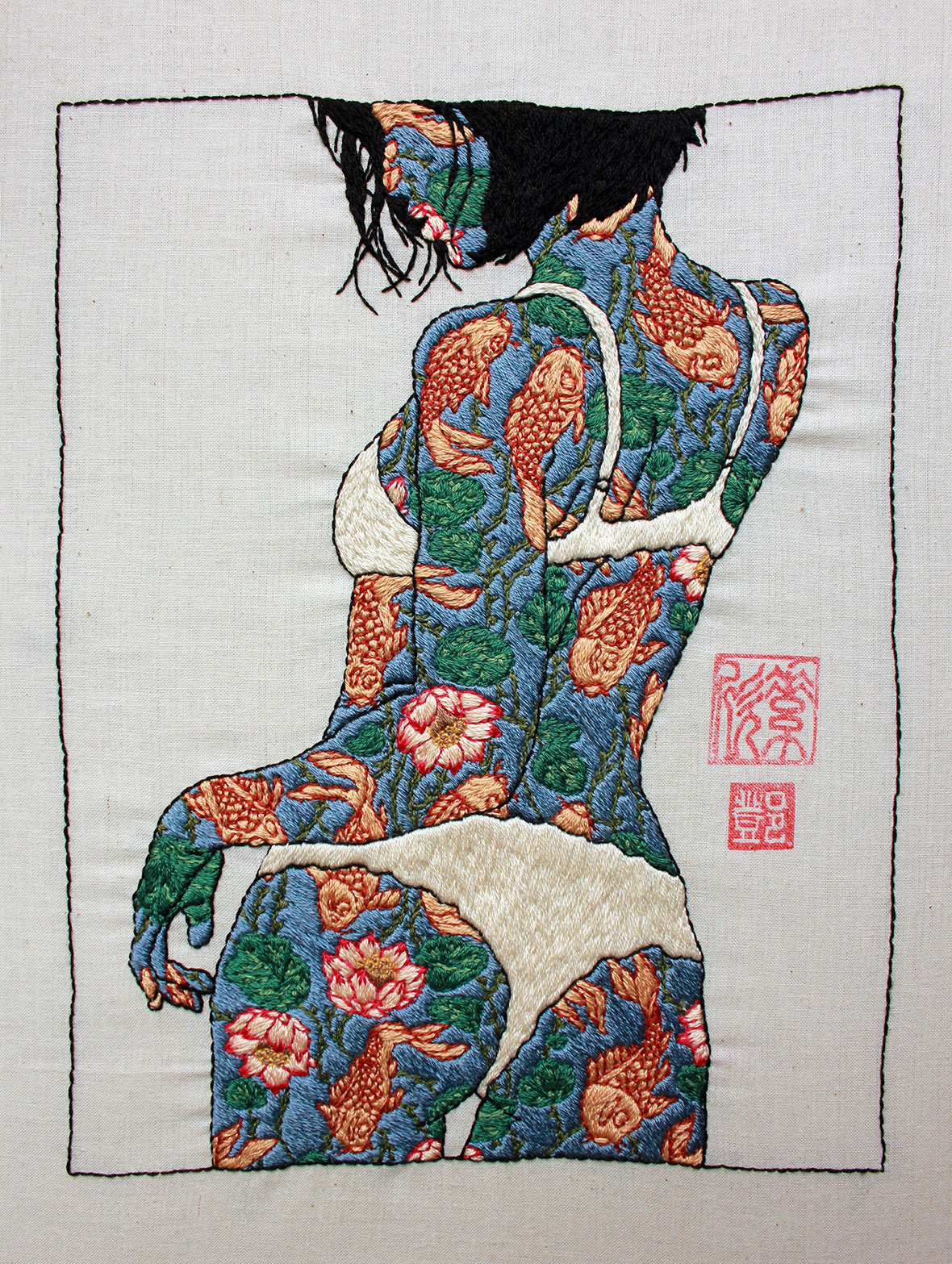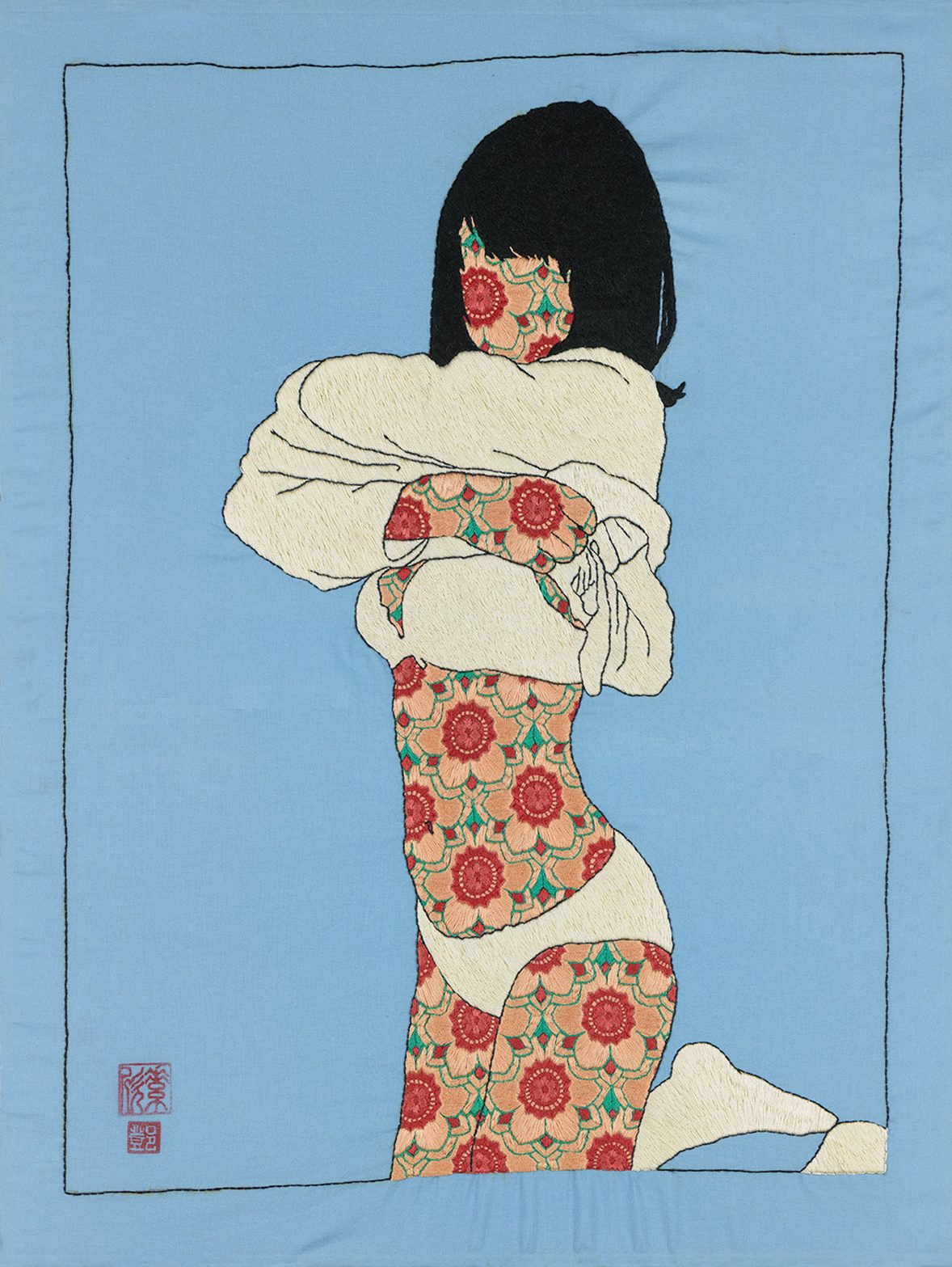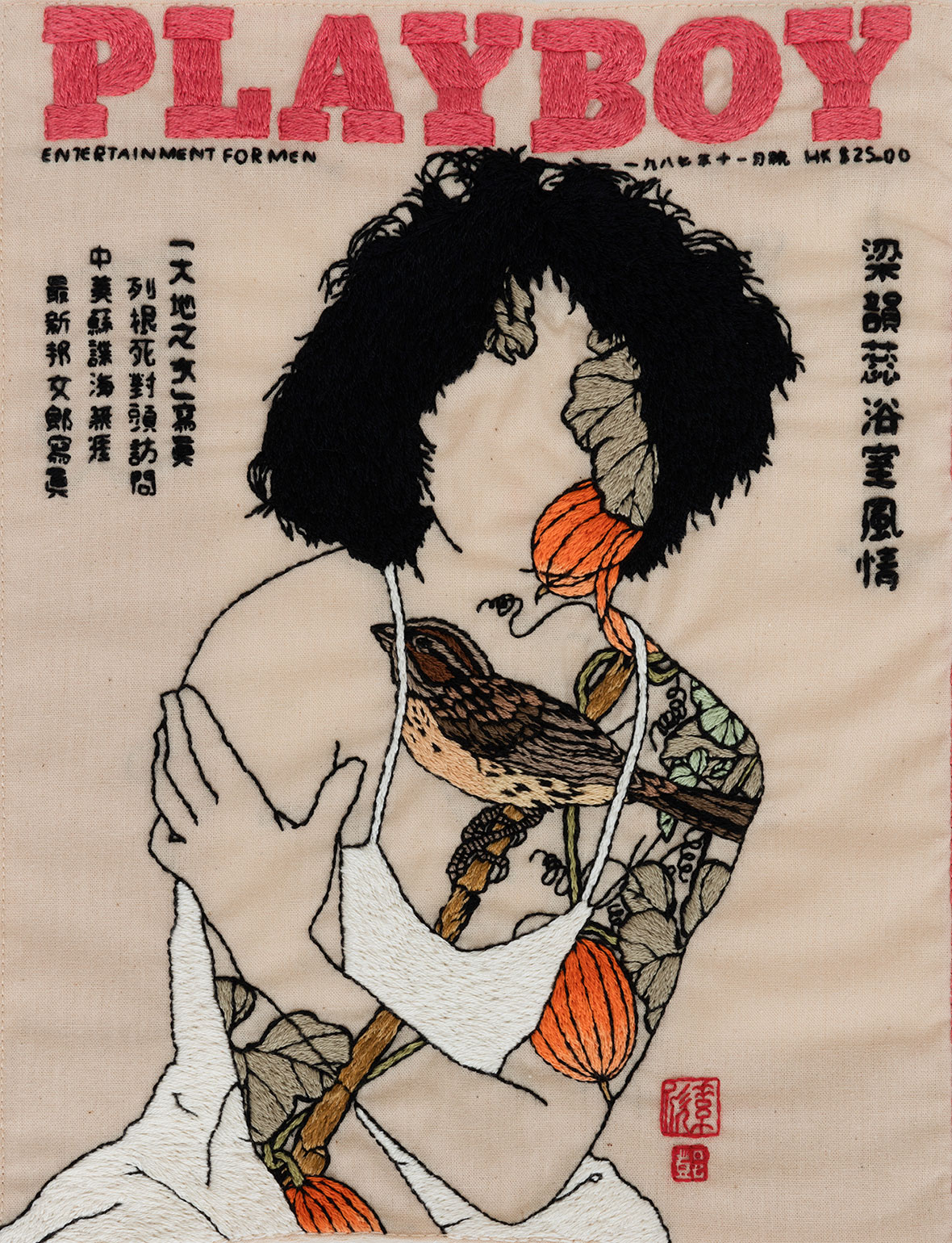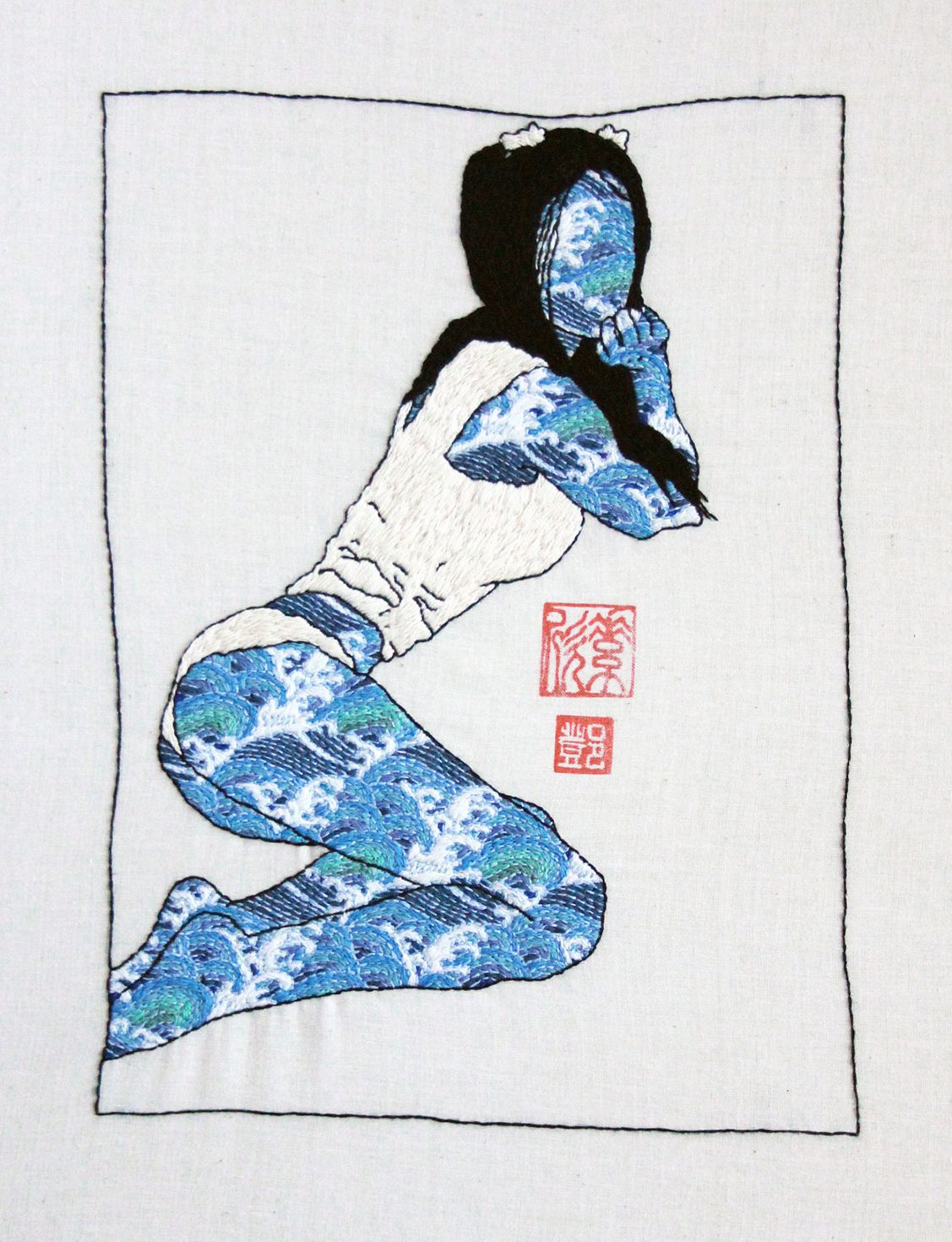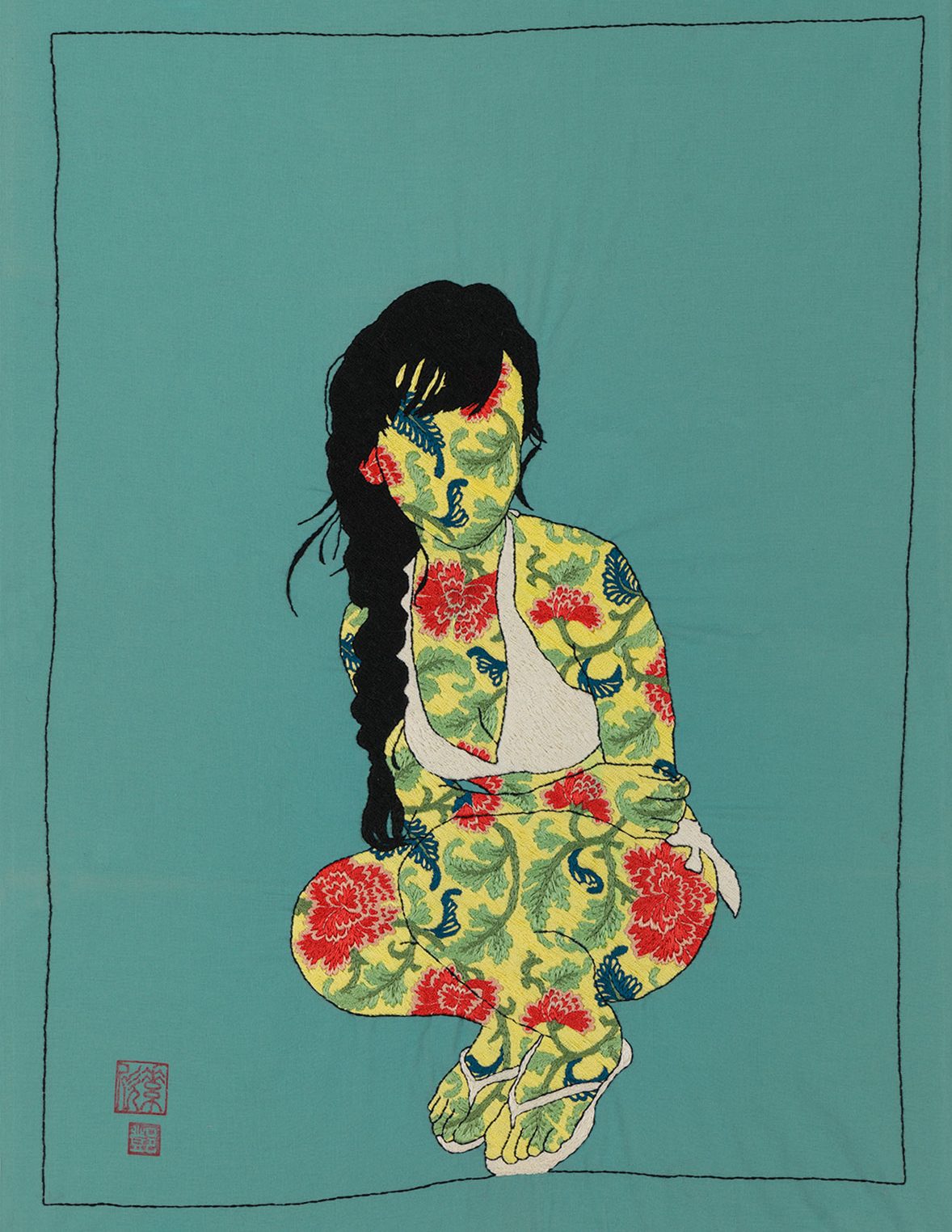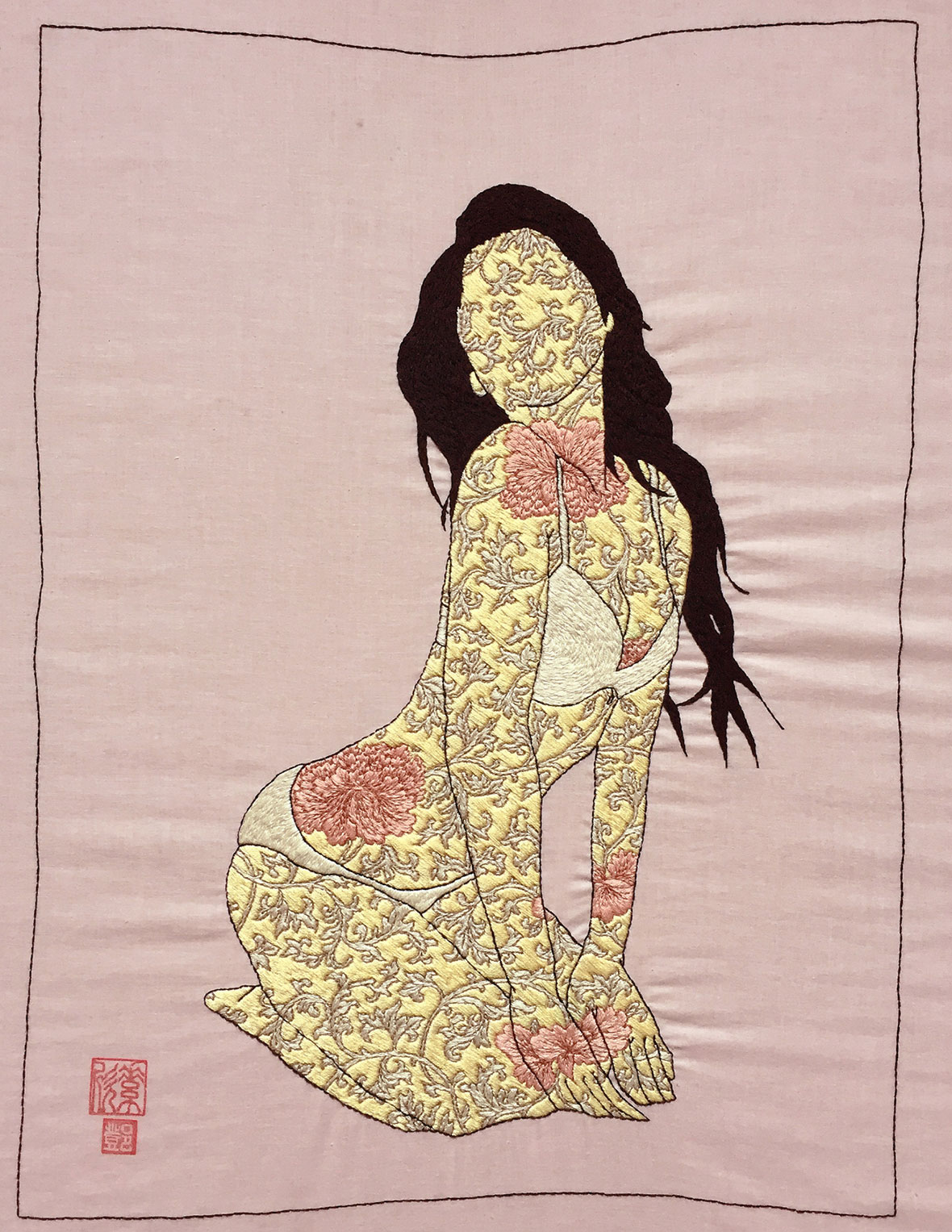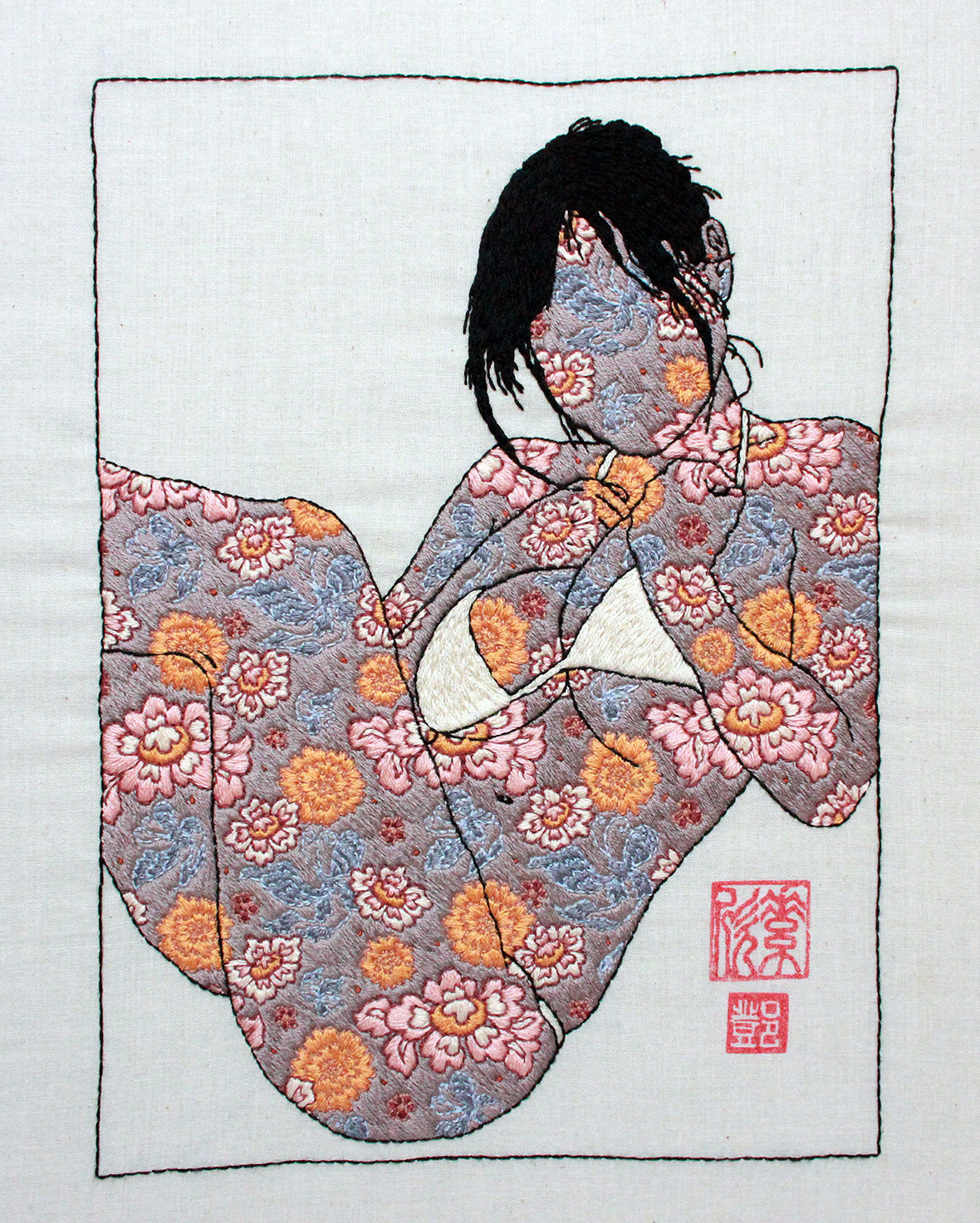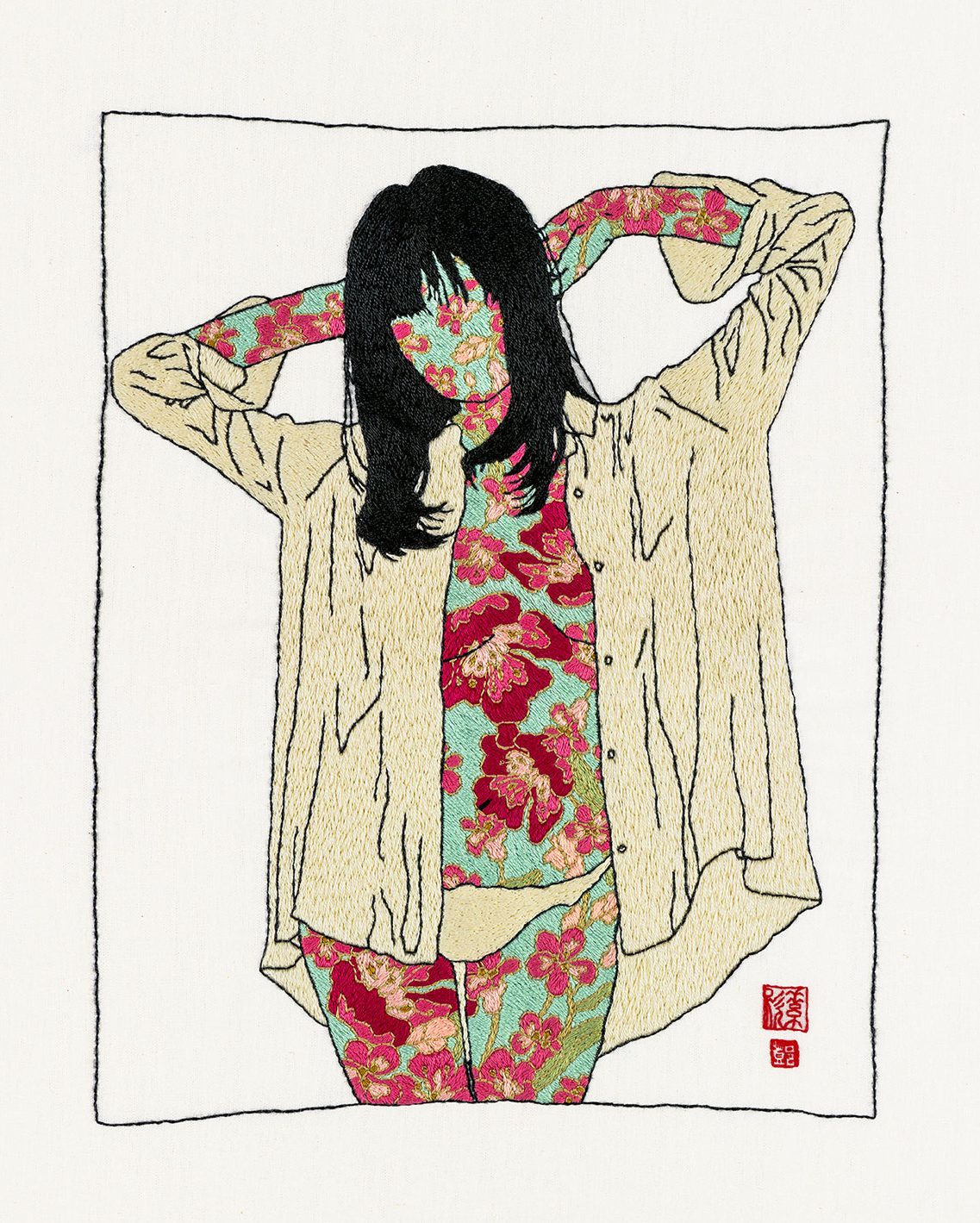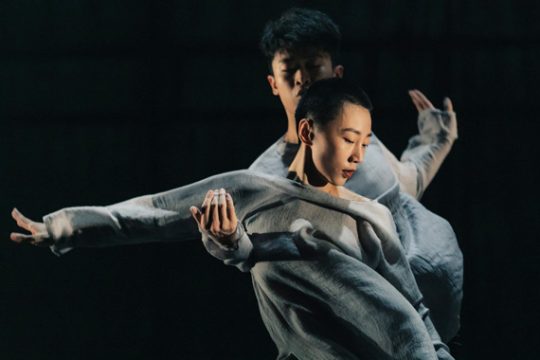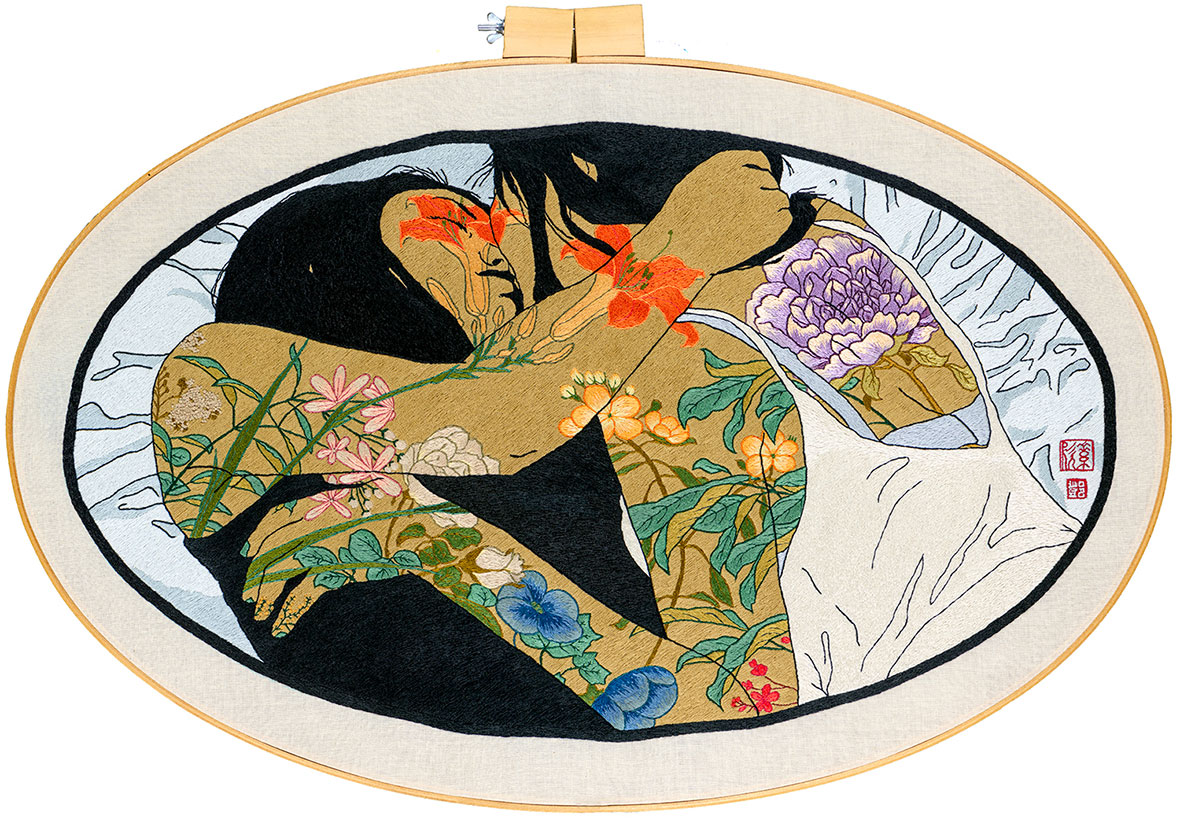
In her series Girl, artist Jessica So Ren Tang embroiders beautiful patterns onto and around feminine figures, overlaying their skin with flora and fauna. The series began as a response to paintings by Ikenaga Yasunari that feature women set before patterned backgrounds. Tang chose to flip this approach and cover the women themselves, fully or in part.
Tang begins by collecting images of women and patterns; she then tries to combine them in different ways to see what looks the best. “I choose the pose first, which affects the pattern, depending on how much surface area there is to cover,” she says. She chooses her subjects based on how striking their pose looks as a silhouette, which dictates the flow of the pattern.
艺术家 Jessica So Ren Tang 在她的《女孩》(Girl)系列中,通过刺绣,打造出身上布满美丽图案的女性形象,将植物与动物图案与女孩的肌肤融合为一。一开始创作这个系列,是因为受到了池永康晟(Ikenaga Yasunari)那些将女性置于精美背景图案前的画作启发。Jessica 反其道而行,直接将图案部分或全部叠加于女性身上。
开始,Jessica 会收集一些女性和图案照片;然后尝试以不同的方式组合,寻找最佳的搭配。“我会先确定人物的姿势,决定有多少面积可以放上图案。”她说。她会根据人物姿势的轮廓来选择创作对象,而这也决定了图案的走向。
Tang, who was raised in San Francisco by parents from Guangdong, chooses the patterns based on scraps of visuals that resonate with the Asian side of growing up Asian-American. These are typically flowers, fruits, and animals that are common motifs in East Asian imagery. Although she says she often chooses patterns by gut feeling, this still yields a cohesive look that binds her work together. In particular, “flowers and fruits have become more of a focus in my work,” she says. “So I’m hoping this way, I can include more symbolic flora from a wider Asian context.”
Once she finds a match between a photo and a pattern, she begins stitching her pieces by hand. “I do not know how to use a sewing machine,” she confesses. She notes that embroidery has a rich history but is often undervalued as “women’s work.”
This makes it an intriguing medium for a series depicting only women, one that underlines the political side of the pieces. For the images of women, Tang uses photo references pulled from magazines, typically of Asian models striking suggestive poses and showing skin. The piece that best displays Tang’s sense of socially charged irony is based on an old Playboy cover, and includes the vibrant red Playboy logo, as well as the magazine’s tagline: “entertainment for men.”
Jessica 从小在旧金山长大,父母是来自广东的移民。作为一名亚裔美国人,她对图案的选择主要围绕亚洲文化意象的视觉元素,都是东亚文化中常见的花卉、水果和动物。虽然她说自己通常都是凭直觉来挑选图案,但最终的作品依然体现着一种整体性。她特别指出:“花卉和水果已经成为我作品中的主要元素。所以,我希望可以通过这种方式,从更广泛的亚洲文化内搜集更多有象征意义的植物。”
一旦她找到合适的照片和图案搭配,就开始手工缝制作品。“我不会用缝纫机。”她坦白道。她说,刺绣是一门有着悠久历史的工艺,却常常被低估为一种“女红”。
对于一个仅描绘女性的系列,刺绣是一种特别有意思的媒介,也有助强调作品的政治意义。对于女性的形象,Jessica 会参考杂志里的照片,通常是摆着撩人姿势、裸露着肌肤的亚洲模特。最能展现 Jessica 讽刺意味的作品是一幅根据花花公子旧版封面创作的作品,上面绣有鲜红的花花公子标志,以及杂志的标语:“entertainment for men”(男人的娱乐)。
By covering women in embroidery patterns, Tang plays with the Western stereotype that all Asians look alike. She weaves a vague, generic “Asian-ness” into her subjects’ skin, intentionally blurring their features and offering a visual illustration of how stereotypes deny people of their individuality. “I’m not necessarily trying to ‘fix’ this idea, more to respond to it,” she explains.
Focusing on “Asian” imagery also reflects her frustration with not being perceived as American because of her appearance. Some people have even assumed she’s not a native English speaker. “I had a freelancer at my office ask where I was from because my English was so good,” she recalls. “Even with a California accent, I’m still considered a foreigner in my hometown.”
通过以刺绣图案覆盖女性身体,Jessica 揭露出西方社会的刻板印象:所有亚洲人看起来都一个样。在她所创作的女性形象上,她编织出一个朦胧、泛化的“亚洲人”形象,故意模糊她们的个人特征,通过视觉的创作,说明刻板印象会否定人们的个性。“我不是在试图‘纠正‘这些想法,只是在作出回应。”她解释道。
着眼于“亚洲”的文化意象,也反映出她因为外表而总是被误以为非美国人的沮丧。甚至常常有人以为她的母语不是英语。“在公司,曾经有一位自由职业者问我来自哪里,因为我的英语说得非常好。”她回忆道, “即使我的英语带着加州口音,即使我在自己的老家,我仍然会被误以为是外国人。”
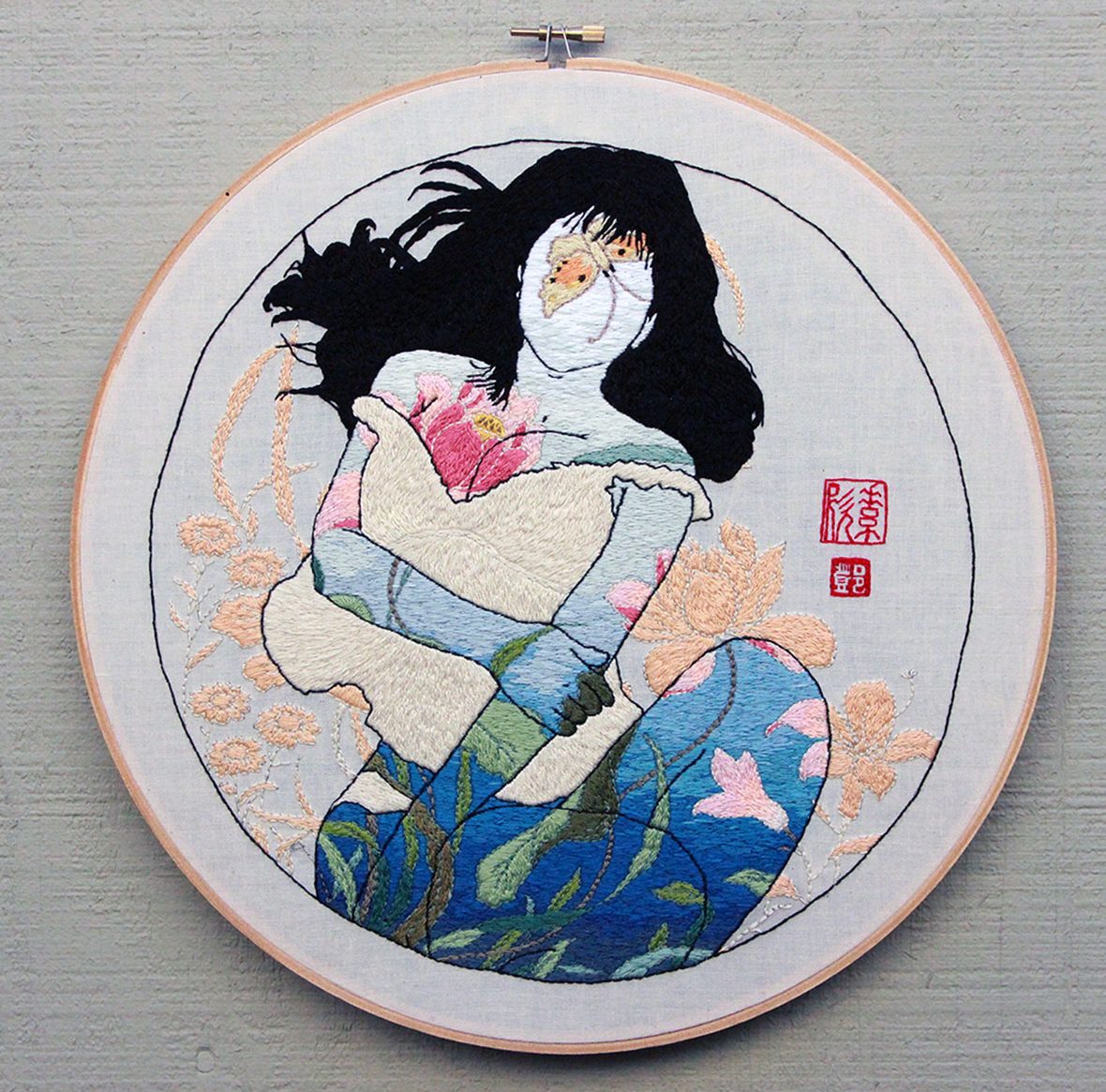

The Girl series thus operates at the intersection between Western perceptions of Asians and men’s ideas of women. Even growing up in ethnically diverse California, Tang’s classmates would sometimes comment on her behavior when she didn’t fit the docile stereotype they seemed to expect of an Asian woman. The series suggests that her classmates’ ignorance comes partly from media representations of Asian women. Tang starts with images that cater to the male, Western viewer by presenting Asian women who look sensual, vulnerable, and available. The overlap between these stereotypical versions of femininity and Asian-ness in turn reflect the male and Western imagination that has directed many media narratives Tang grew up with.
也正因如此,《女孩》系列作品交织了西方社会对亚洲人、男性对女性的偏见。即使是在多元文化的加州,Jessica 在学校的同学有时也会对她的行为指指点点,只是因为她不像他们以为的亚洲女性那样温顺。这一系列也表明,她的同学的无知部分原因在于媒体对亚洲女性的刻板描画。Jessica 先是挑选出那些迎合男性和西方观众的亚洲女性形象,一些看上去性感、脆弱、易于摆布的女性。反过来,女性和亚裔的各种刻板印象相重叠,以这种男性和西方社会的想象引导着许多媒体的描画,而 Jessica 的成长过程中充斥着这种种。
Tang’s point also seems to be that Asian women have historically often had to conform to these stereotypes in order to appear in the media at all. At best, these images are still tokenizations of diversity; at worst, they are purposefully eroticized images that reinforce the notion that Asian women are, in Tang’s words, “docile, submissive, exotic.”
Tang doesn’t just respond to sexualized media stereotypes, she also takes action. In a reclamation of sorts, she removes most or all of the details that form the women’s actual appearance, making them less available to the male gaze.
Jessica 还认为,似乎亚洲女性必须符合这些刻板印象,才有机会出现在媒体上。往好的方面说,这些图像是多样性的标志;往坏的方面说,它们是一种充满性欲化图像,强化了亚洲女性“听话、顺从、充满异国情调”的形象。
对于媒体这些性欲化的刻板印象,Jessica 不只是作出回应,也有实际的行动。她重新修改了作品,删除了所创作的女性大部分或全部的五官细节,以降低这些女性形象的“男性凝视“(male gaze,一种把女性定位于被看者,置于男性凝视主控操纵的现象,译注)价值。
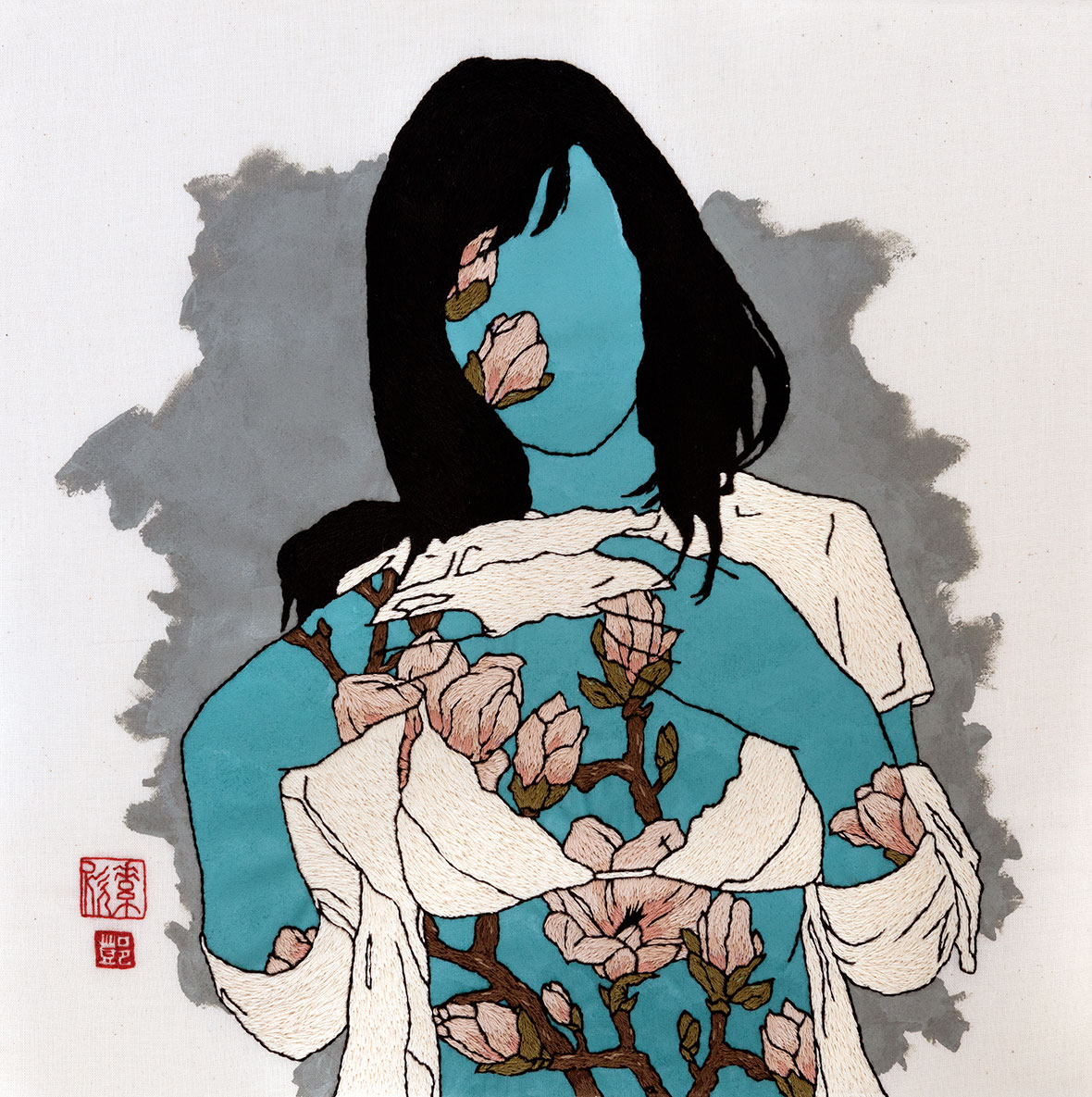
On the other hand, Tang occasionally feels boxed in by being an Asian woman making “Asian and feminine art.” She says, “I have concerns that while exploring my identity in my work, it’s become somewhat of an expectation of me versus making something else, like abstract painting, or something more Western perhaps.” She compares this to other artists who do not limit themselves to imagery or media rooted in their own cultures.
But ultimately, one of the main reasons that Tang continues to create art centered on her identity is because she hopes to encourage other Asian-Americans to do the same, to challenge the idea that Asians shouldn’t do art just because it’s impractical. “It’s too common that I hear about other Asian-American kids being pressured by family into high-paying careers rather than pursuing their passion in the arts,” she says. In this way, her works serve to embolden aspiring Asian-Americans artists, reminding them to take ownership of their own lives and pursue their creative desires without guilt.
另一方面,作为一名亚洲女性,Jessica 偶尔会感到自己被禁锢了“亚洲和女性艺术”之中。她说:“我的顾虑是,在我的作品中探索我的身份时,我对自己的期待已经变成了更西方的东西,而不是创作抽象的绘画。”拿自己与其他并不局限于自己文化的艺术家相比后,Jessica 如是说。
但最终 Jessica 以她的身份为中心创作艺术的主要原因之一是,她希望鼓励其他亚裔美国人也这样做,以挑战“艺术太过不务实,亚裔不会从事此行业”的观念。她说:“我经常听说其他亚裔孩子在家庭的压力下从事高薪职业,而不是追求自己对艺术的热情,这种情况实在是太普遍了。”在这个方面,她的作品给有抱负的亚裔艺术家开了先路,以提醒他们要掌握自己的生活,追求自己的创作之欲。
Like our stories? Follow us on Facebook and Instagram.
Website: www.jessicasorentang.com
Instagram: @jessicasorentang
Contributor: Kiril Bolotnikov

